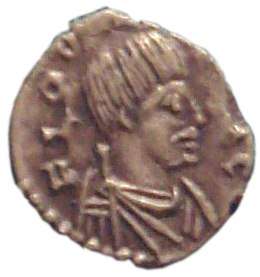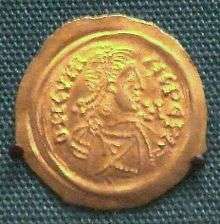Grimoald, King of the Lombards
Grimoald (c. 610 – 671) was a 7th century King of Italy, ruling as Duke of Benevento from 647 to 662, and then as King of the Lombards from 662 until his death in 671.[1]
Life
Grimoald was born in 610 A.D. as the heir of Duke Gisulf II of Friuli and the Bavarian Princess Ramhilde, daughter of Duke Garibald I of Bavaria. From 641 to 642, he and his brother Radoald served as regents to Duke Aiulf I,[2] their adoptive brother. In 647, Grimoald succeeded Radoald as Duke of Benevento.[2] In 662, he assassinated King Godepert and proclaimed himself King of the Lombards. He married Princess Theodota, daughter of King Aripert I.
Reign
Grimoald passed on the title of Duke of Benevento to his eldest son Romuald in 662, following a call to assist King Godepert in a war with his brother King Perctarit. With the aid of Garibald, Duke of Turin, Grimoald assassinated Godepert and forced Perctarit to flee. Grimoald sent Perctarit's wife and son to Benevento and took over as King of the Lombards. He promptly married Godepert's sister Theodota, in order to associate himself with the Bavarian Dynasty of Theodelinda.
His skill in battle secured victories in many border wars. He personally led his armies to victory against the Byzantines (under Emperor Constans II) at the siege of Benevento. Romuald took Taranto and Brindisi, thus reducing the Byzantine influence in the region during Mezezius' rebellion in Sicily. Grimoald took Forlì in the north from the Greeks and razed Oderzo where his brother had been murdered years before. His capture of Forlì on Easter Day was polarizing between Orthodox Christians and Pagan Longobard traditionalists, as many Christians were slaughtered during festivities.
While battling the Byzantines in the Mezzogiorno, he appointed Duke Lupus of Friuli as Regent in the North. Lupus usurped all authority and rebelled; he was promptly crushed, and his duchy destroyed with the help of the Avars. Lupus was killed in battle. Grimoald tracked down Lupus' aspiring son Arnefrit and his Slavic allies, defeating them at Nimis. Arnefrit was killed in battle. Grimoald placed Wechthari, a stalwart enemy of the Slavs, in Friuli.
Grimoald defeated the Franks, who invaded during the infancy of Chlothar III. Grimoald had allied with Perctarit at Asti and the Avars, of whom he had been a hostage in his youth. He saved the northeast of Italy by defeating the Slav tribes and maintained internal order by suppressing the baronial revolts and autonomy of the duchies of Friuli and of Spoleto, where he installed Thrasimund.
In his religion, he remained nominally Arian (though according to Vita Sancti Barbati both he and his son Romuald still practiced the ancient Pagan rights of both Benevento and the Longobard nation) despite his marriage to a Catholic. He distanced himself from the Papacy. However, he perceived Saint Michael—whose cult was spreading strongly from Monte Gargano—as the warrior-protector of the Lombard nation, replacing Wodan (Odin) due to their similar narratives at the time.
He died in 671 after concluding a treaty with the Franks. His son Garibald was not elected to succeed him on account of his youth and was then deposed by the once exiled Perctarit in three months time. Grimoald was popular for his generosity and mercy, as well as his ruthlessness in war. His son Romuald was left in Benevento, which once again drifted away from the central authority.
References
- Chris Wickham, Early Medieval Italy: Central Power and Local Society, 400–1000 (London: Macmillan, 1981), 224–25.
- Andrea Bedina, "Grimoaldo, re dei Longobardi", Dizionario Biografico degli Italiani, 59 (Rome: Istituto dell'Enciclopedia Italiana, 2003).
Further reading
- Gwatkin, H. M., Whitney, J. P. (ed) The Cambridge Medieval History: Volume II—The Rise of the Saracens and the Foundations of the Western Empire. Cambridge University Press, 1926.
- Oman, Charles. The Dark Ages 476-918. London, 1914.
| Regnal titles | ||
|---|---|---|
| Preceded by Radoald |
Duke of Benevento 647–662 |
Succeeded by Romoald I |
| Preceded by Godepert |
King of the Lombards 662–671 |
Succeeded by Garibald |
| Preceded by Perctarit | ||


